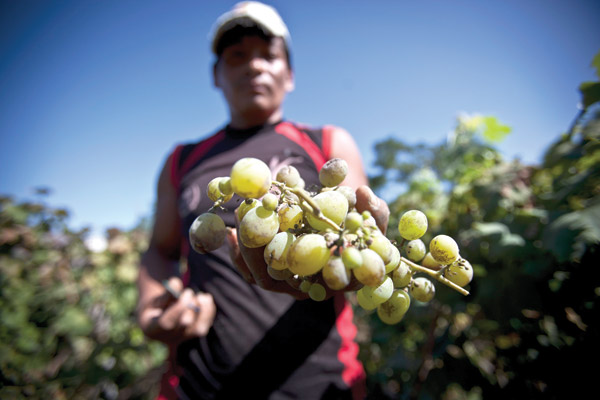Chinese to import more Peruvian table grapes
Updated: 2014-03-31 05:52
By JACK FREIFELDER in New York (China Daily Latin America)
|
||||||||
Exports of Peruvian grapes to China will climb significantly in the 2013-2014 season, the fourth straight year of steady growth, according to an official with the Peruvian-Chinese Chamber of Commerce.
Miguel Galvez Escobar, a market intelligence specialist for the chamber, said exports of Peruvian grapes to China have climbed "more than 50 percent annually" over the last four years.
 |
| Peruvian workers labor to harvest hand-picked grapes for distribution. A leading Peruvian agricultural consultant has estimated the country’s table grape exports will continue to rise between 20 percent and 25 percent annually. [Photo/Agencies] |
"Peruvian grape exports to China have had steady growth from 2010 to 2013," Escobar said on March 27 in an email to China Daily. "Grape imports to the Chinese market grew by 28.3 percent in 2013, and we believe that 2014’s increase should not be less than 35 percent."
Escobar said Peru could become the second-largest supplier of grapes to China in 2015.
The top three suppliers of table grapes to China are Chile, the US and Peru, according to the most recent data from the US Department of Agriculture (USDA).
Peru began exporting grapes to Hong Kong in 1999 and the rest of the Chinese mainland in 2005, with Red Globe table grapes dominating.
At the end of March, shipments stood at more than 37,000 tons ($92.2 million), according to the chamber of commerce.
"There are currently over 100 grape exporters to China, and they all are growing new crops of grapes," Escobar told China Daily. He said the chamber was working with new grape varieties to increase the supply for export to the Chinese market, which "is becoming more demanding and competitive."
China is Peru’s largest trading partner, replacing the US in October 2011, according to Andina, the Peruvian news agency.
The two most commonly known types of grapes are the wine and table varieties. Table grapes are normally larger, seedless and tend to be more physically appealing, while wine grapes are smaller, more concentrated and have a more potent flavor.
About 90 percent of grapes in the world come from the same species, Vitis Vinifera, according to the wine advocate group Professional Friends of Wine.
A paper published in 2008 by the Julius Kükn-Institut — the German Federal Research Centre for Cultivated Plants — said that the Vitis subfamily "contains more than 70 species," with centers of origin on all of the continents except for Antarctica.
The paper, titled A Review of Taxonomic Research On Chinese Wild Grapes, states that "China is one of the major gene centers of Vitis species origination," with more than 35 species indigenous to China.

 China's FDI into US zeroing in on high-tech sector
China's FDI into US zeroing in on high-tech sector
 World Bank to bolster fight on poverty, inequality
World Bank to bolster fight on poverty, inequality
 Trip builds bridge to Europe
Trip builds bridge to Europe
 Massive earthquake hits Chile
Massive earthquake hits Chile
 Venezuelan anti-govt protestors set on fire in rally
Venezuelan anti-govt protestors set on fire in rally
 Sino-US relations going mainstream
Sino-US relations going mainstream
 Chinese moving into E. Harlem
Chinese moving into E. Harlem
 Two Koreas exchange artillery fire
Two Koreas exchange artillery fire
Most Viewed
Editor's Picks

|

|

|

|

|

|
Today's Top News
Japan removes export ban on military goods
Asiana admits pilot error in fatal crash
Sina Weibo picks Nasdaq for IPO
5 dead in 8.2 quake off Chile
NY Councilman meets 'the press'
MH370 'unlikely' to hurt ties
Xi's trip builds bridge to Europe
Weibo to list on Nasdaq
US Weekly

|

|







